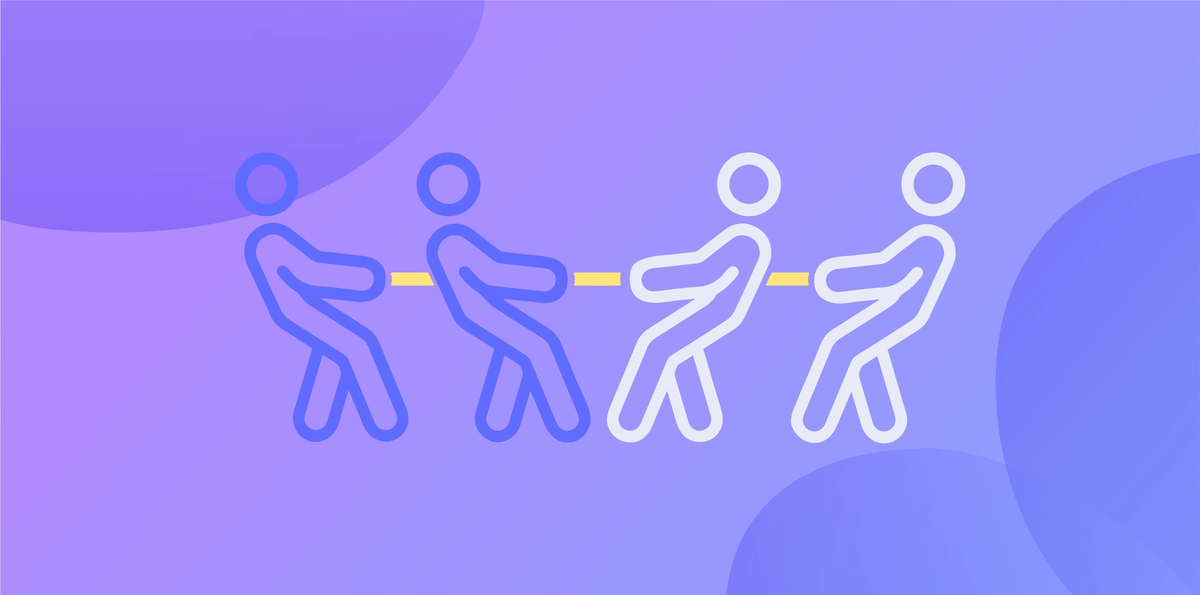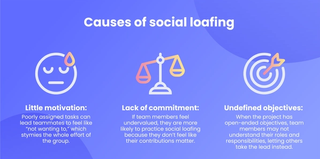Social Loafing: Does Teamwork Actually Make the Dream Work?

What is social loafing?
No, social loafing isn’t when you and all your closest friends get together and eat a variety of delicious breads and pastries. But it does have something to do with a group of people… 🤔
Social loafing happens when a person does less when working in a group compared to putting in the full effort if they were working alone. We’ve all been social loafers at some point, whether in school, on a sports team, or at work. It’s the thought, “The group has it under control, so I’ll just sit back.”
Don’t be sour, dough. We’ll give you all the tips and tricks to combat social loafing before it happens.
History of social loafing
Maximilian Ringelmann discovered it in the early 1900s when he observed that group pulling power in a tug-of-war game was less than the sum of the individual strengths. In fact, he noticed that the average contribution decreased each time a new member joined the game. This phenomenon suggests that members put in less effort as group size grows, and goes against the common idea that “teamwork makes the dream work.”
But is it true? What do modern psychologists have to say about the Ringelmann Effect?
In the 1970s, Alan Ingham reconducted the experiment with students at the University of Massachusetts. However, his version of the study had a twist: he asked a select group of participants to just pretend they were pulling the tug-of-war rope. The experiment produced the same results, even with fewer people tugging. What this variation demonstrated was that it didn’t matter whether people were part of a larger team or just thought they were, they worked less hard.
As opposed to Ringelmann’s conclusion that effort is correlated to group coordination, Ingham found that teammates reduce their efforts in a group because they feel less responsible for the output. Through these experiments and many more of its kind, studies have shown that the ideal team size for peak productivity is four people, or at most, five members.
Types of social loafing with examples
Social loafing comes in various forms and sizes. Someone could be a “free rider,” a “sucker,” or even a combination of the two, depending on the situation at hand.
The Free Rider Effect 🏄
Sit back and relax, let everyone else take on the responsibility. When one team member displays a casual attitude towards a group project, they contribute less to achieving the overarching group goals. When the participation of different members of the group varies by a large degree, with some people doing 95% and the others doing 5%, it creates an unbalance in the productivity of the group.
Remember back in high school science class and you were partnered with Catherine Brainypants, the smartest biology kid around? You let her do the bulk of the research because it was just easier and you knew your A+ was in the bag. (But don’t feel bad, you bought the poster and carried it to class.) This is a prime example of social loafing through the free rider effect.
The Sucker Effect 🍭
No one wants to be the sucker. You know, the one who’s carrying the team. The sucker effect occurs when an individual realizes they are doing more than their fair share of the group’s work and to reduce the unfairness of the situation, they also reduce their own level of effort.
Okay, flip to the other perspective of the story. You’re Catherine Brainypants and you see that your partner is slacking, letting you do all the work! So you stop doing all the research and wait for your team to do something. (Knowing you, you probably have a backup plan so you don’t get a terrible grade). But the act of stopping your research is another instance of social loafing.
Causes of social loafing
In most cases, people revert to social loafing when they feel they’re not going to contribute much to the group and decide that their participation is optional to the success of the assignment. In the workplace, this can happen in two scenarios: through preexisting indicators or poor management

Indicators
Indicators are factors that make you feel like not participating in the group. While everyone has certain indicators that make them less willing to contribute, there are three overarching ones that are backed by science:
Little motivation: Poorly assigned tasks can lead teammates to feel like “not wanting to,” which stymies the whole effort of the group.
Lack of commitment: If team members feel undervalued, they are more likely to practice social loafing because they don’t feel like their contributions matter.
Undefined objectives: When the project at hand has open-ended objectives, team members may not understand their roles and responsibilities, letting others take the lead on the assignment.
Management
The way a team is managed also has a great effect on how often the members social loaf. Typically, the indicators mentioned above are triggered when individual work isn’t recognized or there is an absence of individual evaluations. Whether we like to think it's true or not, people like the opportunity to shine. ✨ If working in a group means the assignment is judged as a whole, individual members may feel willing to slack off or do less to contribute.
How to avoid social loafing in the workplace
While the best way to get rid of social loafing is to reduce your team size to four or less people, that's not always the most viable option. So here are the best ways to go about social loafing in the workplace.
Divide and conquer: If you are taking charge of a group, a way to prevent social loafing from the get-go is to break up project tasks into manageable parts that can be distributed to teammates.
Collaboration: Assign every team member their own meaningful task and hold them accountable. You can track the progress of the project on a kanban board to make sure everyone is making significant progress on their part of the project.
Content: The key to collaboration and seamless teamwork is to make sure every person is happy with their role in the project. It is important for team members to have tasks that fit their personal attributes, interests, and strengths. It gives people the space to shine within the group.
The collaboration tool you need
So to answer the question, does teamwork actually make the dream work, phycology says, “sorta.” Smaller teams, from two to four people tend to be the most productive because every person is likely to have an active role that contributes equally to the overarching goal. Team sizes larger than four require some extra attention. In order to maximize productivity and avoid social loafing, project managers should keep in mind collaboration and positive words of affirmation.
If you’re looking for a collaborative platform for your whole team, Collato is the place for you! Our customizable templates let you plan your content, assign tasks to teammates, set publication dates, give and receive feedback, and store files and digital assets all in one place. It’s the perfect place to collaborate with your team, whether you have four team members or more!
